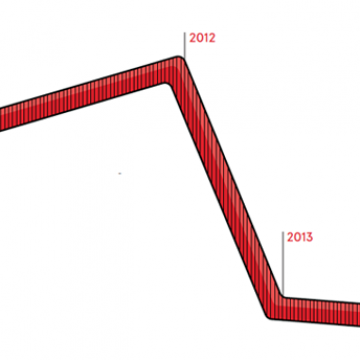In the immediate wake of the economic downturn, the slump was in clear view. Across Bay Street, law firms hired back fewer and fewer articling students as first-year associates. Yet, in recent years, the bleeding has stopped.
Let’s go back to 2010. In that year, according to hiring data Precedent tracks each year, the largest 16 law offices in Toronto hired back 224 students. And by 2013 that number had fallen to 204. But in the last two years, that number has barely moved, settling at 200 this year — a historical low, yet also a sign of stability.
“At this point, just not having a decline is a good thing,” says Gene Roberts, a director at the lawyer-staffing firm Robert Half Legal. “It shows firms are becoming more stable.” His optimism is further fuelled by a recent survey, published by Robert Half, which shows that nearly one-third of Canadian lawyers expect their firms to “slightly” increase entry-level hiring in the next year. “I think things will remain steady, or punch up a bit.”
For mid-level associates, meanwhile, the job market is particularly healthy, says Adam Lepofsky, president of the legal recruiting firm RainMaker Group. “No one’s going crazy, but we’ve seen more hiring in the past six months than we did the last five or six years.”
Still, experts agree that a first-year hiring boom — or a return to pre-recession numbers — is unlikely in the short term. For one thing, large firms still have less work than they did a decade ago, says Chris Williams, co-owner at Branion Williams Legal Recruiting. “There don’t seem to be as many deals happening. We’re still hurting from the recession,” he says. “There’s less work trickling down to associates. And obviously you’re not going to hire as many students if you don’t have the work to sustain them.”
The post-recession law firm is also a less reactionary machine, says Lepofsky. So even if business soars, he says, firms might not go on a hiring spree, knowing that the market could turn at any moment, forcing them to purge lawyers. “Firms realize they have to be prepared for the ups and the downs.”
Even if major growth is not on the horizon, three years of consistent hiring of new calls is impressive, says Lepofsky. “This is still a very dicey economy,” he explains. “It’s amazing to see firms, in this climate, continue to hire and train lawyers.” The establishment of a new hiring equilibrium, he adds, shows that firms have adapted to the new market. “Firms are smart. They evolve and fine-tune themselves so that, like other organizations, they’ll stay profitable.”
Exclusive Precedent research shows how the number of articling students hired back at Toronto’s largest law offices has changed in five years:
Firm
|
Total Hirebacks 2010 |
2015 |
|
|---|---|---|---|
| Osler | 29 | 18 | ↓ |
| Blakes | 26 | 20 | ↓ |
| McCarthys | 18 | 15 | ↓ |
| BLG | 17 | 17 | = |
| Torys | 15 | 20 | ↑ |
| Department of Justice | 14 | 3 | ↓ |
| Stikemans | 13 | 13 | = |
| Faskens | 13 | 12 | ↓ |
| Bennett Jones | 12 | 11 | ↓ |
| Gowlings | 12 | 9 | ↓ |
| Norton Rose (previously Ogilvy Renault) | 11 | 12 | ↑ |
| Davies | 10 | 11 | ↑ |
| Cassels | 10 | 8 | ↓ |
| Goodmans | 9 | 13 | ↑ |
| McMillan | 8 | 7 | ↓ |
| Dentons (previously FMC) | 7 | 11 | ↑ |
| Total | 224 | 200 | ↓ |
 This story is from our Fall 2015 issue.
This story is from our Fall 2015 issue.


